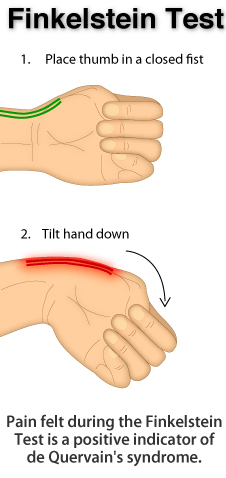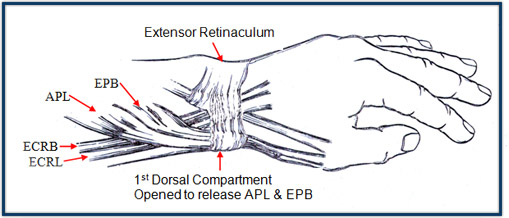By Reece Jones
Here is a quick test to help work out if your wrist and/or thumb pain is De Quervains
 De Quervain’s: Have you got wrist or thumb pain?
De Quervain’s: Have you got wrist or thumb pain?
Named after the Swiss surgeon who first identified the condition, Dr. Fritz de Quervain, is today known as blackberry thumb.
De Quervains affects the two tendons of the thumb. Tendons are the connective tissue that attaches a muscle to bone. The tendons affected in De Quervain’s are the abductor pollicis longus (APL) and extensor pollicis brevis (EPB) and travel side by side along the thumb side of the wrist. Just like a fishing pole, these tendons run through a tunnel that helps keep them in place. This tunnel is lined with a slippery coating called tenosynovium that allows the tendons to move back and forth easier. Sometimes this slippery coating can become inflamed and therefore these tendons become painful when moving the thumb, pinching, or grasping objects.
Causes:
The cause(s) are unknown. Evidence has suggested the following do place an individual at a higher risk of developing the condition:
– Age – 30-50 years places you at a higher risk
– Gender – Females are more likely than males
– Pregnancy – Strong link with this condition and pre/post pregnancy
– Work habits – Occupations that involve repetitive hand/wrist and thumb movements places you at higher risk
– Social habits – Overuse of the thumb with texting is becoming more evident
– Medial Conditions – Diabetes, alcoholism and epilepsy increases the risk

Possible Signs and Symptoms:
There are multiple signs and symptoms of De Quervain’s, you may have either just one or multiple. Firstly, pain and tenderness at the thumb side of wrist is the most obvious symptom. This is usually aggravated with wrist and/or thumb movements, and as a result making grasping and twisting difficult (e.g. turning a key). This pain can sometimes radiate into the thumb and even cause numbness and swelling. Finally, the pain is sometimes followed by catching and/or snapping of the thumb during wrist or thumb movements.
Can MGS help:
Yes we can help at MGS! Firstly it is important to diagnose the condition correctly as other conditions can mimic the signs and symptoms such as OA of the thumb. If the physiotherapist has diagnosed De Quervain’s then your thumb and wrist will be placed in a removable splint that will reduce your pain and rest the tendons. The physiotherapist may prescribe specific exercises to help address any problems that may be causing the issue. Finally, the physiotherapist will advise you on any activities that are likely to make your pain worse. Evidence suggests anti-inflammatory tablets and cortisone injections can also improve symptoms.
